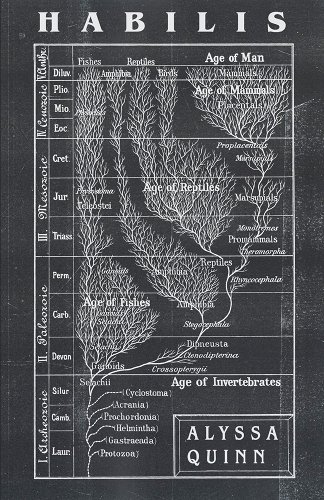[ad_1]
In her insightful and ambitious debut novel, Habilis, Alyssa Quinn takes us on a destabilizing journey through the experiences of several beings by means of a single, muddled existence, illustrating the connectedness of all life and challenging the notion of a discoverable, and inherently meaningful, point of human origin. Through techniques and analyses both erudite and playful, Quinn forces us to separate the strands of our most mundane practices, and bring each up close to our faces. Not because one strand alone will hold the key to a more profound understanding of ourselves as individuals, but because each must be properly understood before we can even attempt to understand the whole. Spoiler alert: we will never fully understand the whole, and that’s okay.
The story begins with Lucy, one of many revelers in a museum of anthropology that converts into a discotheque at night. “It’s radical I know, but we were facing bankruptcy” is the explanation given by Lucy’s friend, and museum curator, Dina. Lucy and Dina dance, drink, and scream over the music to be heard by one another and whomever else they try to talk to—including an evolutionary psychologist named Nathan, and a floating assortment of bones referred to as OH 7. As the night wears on, Lucy notices a female Homo habilis hovering at the edge of things, and recognizes her humanity. Lucy later peels away from the crowd, mentally and physically, to study the museum’s exhibits in conjunction with her own imprecise history.
Though the elements mentioned in the above summary might seem disparate, connectedness is explicitly referenced and also adhered to at every level of the novel. One of the most intriguing examples of this is the threading together of dialogue from multiple speakers. When Lucy is introduced to Nathan, he remarks on the expression she wears upon finishing her drink. Their exchange is presented as follows: “Disgust, says Nathan. Excuse me? Your expression, he says.” All dialogue is italicized rather than bookended by quotation marks, and embedded within a single block of text as opposed to separating each speaker’s words into new paragraphs. The conversation continues, “I don’t like the green things, she says. You mean olives? Yes. Olives. Disgust is fascinating, says Nathan.” Despite the flow of one character’s dialogue into another’s, the thread of who is speaking at any given moment is never lost. It would be easy at this point in the story (which is quite early on) to dismiss this narrative choice as a quirk of the author. However, reading further reveals how central the theme of connectedness is to this novel. If the dialogue runs together, a reader might mistakenly attribute all of it to a single character, which would serve this story perfectly.
The bulk of the narrative alternates between the descriptions accompanying each museum exhibit, which often include scenes snipped from history and mined as much for what is considered known fact as for what is ultimately unknown (such as the possible moment when discovering a large animal carcass instigated protohuman evolution), and Lucy’s private ruminations of her past and present. The museum utilizes dioramas, casts of objects and long-gone presences (i.e. footprints), and of course actual historical objects: fossils, bones, minerals, ancient tools, etc.
There are comparisons throughout the novel between the behavior of humans and that of other animals. A museum exhibit on “signaling theory” states that every communication sent by a non-human animal has an exact purpose (e.g. deterring an enemy, or attracting a mate). The human concept of “language” is not only unnecessary to other creatures, but is too convoluted for their purposes. The difference between life and death is often a single, instinctual gesture. With only language at our disposal, humans must depend on an ability to persuade that they may or may not have. Whereas “the young springbok” only needs to “[leap] into the air, back arched, legs stiff, head pointing down” to indicate to predators that they are “not worth chasing.”
Another exhibit notes the referential nature of animal signals. Because certain actions or cries can only take place under particular circumstances, they can clearly be trusted. However, humans have the unique ability to “point at what is not there”—a phrase that appears throughout the novel—as in the ability to refer to objects or situations that are not present, and perhaps never were.
Later, Dina mentions a study that reveals how little time people spend looking at museum exhibits. “Two seconds” to look at the exhibit, and “ten seconds [to read] the label, look briefly back at the exhibit, then move on.” Humans, Dina claims, only ever “point at what isn’t there,” whether in a museum, or within our own minds, dwelling on what is behind and before us as individuals, or as a species, which speaks to the human practice of living anywhere but in the present moment. All moments, all occurrences, like the dialogue, bleed into one. The position of the tongue at every possible instant of movement as we form a single word; the broken down metamorphosis of sounds an infant makes as they become words; the exact depth at which the surface of a lake becomes the body of a lake—where “outside become[s] inside.” Each is cataloged and explored in one of the museum’s exhibits, the seconds-long viewing of which would of course, ironically, be lost to the flow of time and referenced only when it is no longer present.
Over the course of the novel, Lucy recalls fragments of her time in foster care while at the same time gradually losing her command of language. Eventually, she tries to express certain thoughts, but utters completely unrelated phrases instead. This inability to communicate is connected to her inability to know herself completely, as aspects of her past remain lost to her. What she does remember is the troubling non-presence of a former foster sister, and the effect of lying about her presence to her foster mother, who explicitly asks her to point at her lost daughter’s ghost, which is not actually there.
At the center of the museum, Lucy encounters an exhibit that recounts moments in the lives of a British anthropologist, an Indian indentured worker building the Uganda Railway, and a curator who speaks directly to the reader (of the exhibit plaque, and the novel). This exhibit is where the ideas we have been introduced to throughout the novel culminate, as characters confront and embody absence, and are then forced to refer to people, things, and circumstances that no longer exist, or never did. Habilis explores an impressive array of ideas despite its brevity. Quinn holds open a doorway to everything known and unknown about the lives and times of Earth’s inhabitants. Crossing its threshold, you will immediately find yourself back where you began, somehow at peace with the answers you were never given.

FICTION
Habilis
By Alyssa Quinn
Dzanc Books
Published September 13, 2022

[ad_2]
Source link

